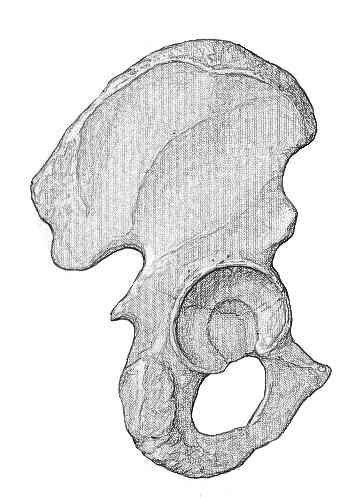 - Discussion:
- Discussion: - see native acetabular anteversion and femoral anteversion and acetabular component position
- general considerations:
- simple visualization of length of anterior/posterior walls gives an accurate measure of native anteversion;
- references:
- Femoral anteversion in THA and its lack of correlation with native acetabular anteversion.
- The effect of the orientation of the acetabular and femoral components on the range of motion of the hip at different head-neck ratios.
- Does Acetabular Retroversion Affect Range of Motion after Total Hip Arthroplasty?
- The 2014 Frank Stinchfield Award: The 'landing zone' for wear and stability in total hip arthroplasty is smaller than we thought: a computational analysis.
- effect of decreased/insufficient anteversion:
- references:
- Influence of component positions on dislocation: computed tomographic evaluations in a consecutive series of total hip arthroplasty.
- Dislocation After Total Hip Arthroplasty. Causes and Prevention.
- Factors predisposing to dislocation after primary total hip arthroplasty. A multivariate analysis.
- Acetabular revision for recurrent dislocations: results in 14 cases after 3 years of follow-up.
- Position, orientation and component interaction in dislocation of the total hip prosthesis.
- Iliopsoas Impingement After Primary Total Hip Arthroplasty: Operative and Nonoperative Treatment Outcomes.
- effect of increased/excessive anteversion:
(see painful hip replacement)- impingement will occur in hip extension/ER during the toe off phase;
- posterior impingement (due to increased anteversion) will be increased with addition of posterior positioning of the extended rim;
- references:
- Increased anteversion of press-fit femoral stems compared with anatomic femur.
- Anterior dislocation of a total hip replacement. Radiographic and CT-scan assessment. Behavior following conservative management.
- Posterior femoral neck impingement secondary to excess acetabular anteversion in hip resurfacing arthroplasty.
- The spatial location of impingement in total hip arthroplasty
- Cup-neck impingement due to the malposition of the implant as a possible mechanism for metallosis in metal-on-metal total hip arthroplasty.
- Anterior Subluxation after Total Hip Replacement Confirmed by Radiographs: Report of Two Cases
- Anterior Dislocation Following Primary THR by the Posterior Approach — Aetiology and Treatment
- Increased Anteversion of Press-fit Femoral Stems Compared With Anatomic Femur
- Intraoperative Determination of Component Anteversion:
- patient position:
- if the patient is tilted posteriorly, there will be a tendency to ream the component in retroversion (and vice versa);
- in the lateral position, if the patient's pelvis is flexed relative to the torso, the surgeon the ream the component in a
retroverted position (if degree of anteversion is calculated off of patient's torso);
- references:
- Accuracy of intraoperative assessment of acetabular prosthesis placement.
- Combined Anteversion Technique for Total Hip Arthroplasty
- Native Anteversion:
- Does Native Hip Anatomy Fit Recommendations for Safe Component Orientation in THA?
- Femoral Anteversion in THA and its Lack of Correlation with Native Acetabular Anteversion.
- Comparison of native anatomy with recommended safe component orientation in total hip arthroplasty for primary osteoarthritis.
- McCollum's line extends from anterosuperior iliac spine to the sciatic notch;
- this gives a reproducible landmark to help the surgeon gage the proper angle of reaming;
- generally the line of reaming and cup insertion is either perpendicular to McCollum's line or is slightly anterior to the line;
- safe rande for flexion was 20 degrees to 40 degrees;
- when cup was positioned in 20 deg flexion impingement was occasionally noticed w/ hip flexed to 90 deg & IR to 90 deg;
- to eliminate impingement of prosthetic neck against the prosthetic cup, flexion was increased to 30 degrees;
- Transverse acetabular ligament as a refererence for anteversion:
- The Transverse Acetabular Ligament: Optimizing Version
- Anteversion of the acetabular component aligned with the transverse acetabular ligament in total hip arthroplasty.
- Is transverse acetabular ligament an anatomical landmark to reliably orient the cup in primary total hip arthroplasty
- The role of the transverse acetabular ligament for acetabular component orientation in total hip replacement: an analysis of acetabular component position and range of movement using navigation software.
- The transverse acetabular ligament may be used to align the acetabular cup in total hip arthroplasty
- Acetabular component positioning using the transverse acetabular ligament: can you find it and does it help?
- The relationship of the orientation of the transverse acetabular ligament and acetabular labrum to the suggested safe zones of cup positioning in total hip arthroplasty. - Reducing the rate of early primary hip dislocation by combining a change in surgical technique and an increase in femoral head diameter to 36 mm.
- Total hip replacement through a posterior approach using a 22 mm diameter femoral head : the role of the transverse acetabular ligament and capsular repair in reducing the rate of dislocation.
Postoperative Radiographic Evaluation:
- measurement of postoperative anteversion:
- Anteversion of the acetabular cup. Measurement of angle after total hip replacement.
- A simplified method to determine acetabular cup anteversion from plain radiographs.
................................................................................................................................................................................................................................................................................

